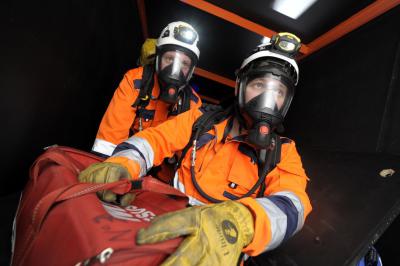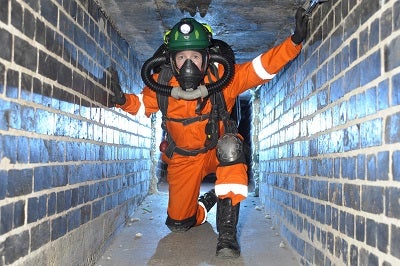As per Regulation 4 of the Confined Spaces Regulation 1997 – entering a confined space should be avoided, where possible. If entry can’t be avoided – then it is necessary to put a safety system of work in place.
Key to producing a safe system of work is a confined space risk assessment.
A safe system of work (SSoW) is a step by step set of instructions which details how a task should be undertaken, so it is safe. A SSoW considers risks and how control measures, from a risk assessment, will be implemented or used. A risk assessment should be completed to produce a confined space SSoW.
What is a risk assessment?
A risk assessment, for a confined space or not, identifies hazards and risks which need to be addressed to keep employees safe.
The Health and Safety Executive (HSE) defines a risk assessment as:
“A careful examination of what, in your work, could cause harm to people, so that you can weigh up whether you have taken enough precautions or should do more to prevent harm…”
What is a confined space risk assessment?
If workers are required to work or enter a confined space – an employer must appoint a competent person to undertake a confined spaces risk assessment.
A confined space risk assessment follows the same steps as a normal risk assessment but takes into consideration the hazards which present themselves in confined spaces specifically – such as lack of oxygen or an explosive atmosphere.
It is crucial that before any worker enters a confined space, they are aware and confirm all hazards present have been identified on the risk assessment, and that suitable controls are in place.

To be effective, risk assessments should follow 5 steps:
Step 1: Identifying hazards
As previously mentioned, regulation 4 of the Confined Spaces Regulation 1997 states that entering a confined space should be avoided and only entered if necessary. If entry is imperative, then it’s heavily recommended and the legal duty of employers to put a safety system of work in place – identifying hazards is the best place to start in an effective risk assessment.
A risk assessment should identify potential hazards in a workplace or confined space. A hazard is anything that has the potential to cause harm. A hazard in isolation, is not necessarily harmful – but interaction with something else (i.e. a person) may make it harmful.
Usually, the person responsible for conducting a risk assessments walks around a workplace to identify potential hazards. In addition to this, a risk assessor may also look at equipment or chemical instructions, past accident or ill-health records or routine plans to identify hazards, and should also seek participation from those who normally carry out the work.
Assessing a confined space is slightly different. An assessor needs to take into consideration other factors – such as:
- The physical dimensions of a confined space
- Entry, exit and rescue points
- Contamination
- Risk from adjacent processes
- Previous content and any residues
In addition to the above points, an assessor should also consider the competence of operators (a legal requirement), the nature of supervision and if there is a requirement for a specialist rescue team or rescue arrangements, and notification of emergency services.
Step 2: Decide who may be harmed, and what that harm would look like
After identifying hazards – the assessment will then list who may be affected by each hazard. The assessor does not name individuals, instead they identify groups. For example – ‘people working in the factory’ or ‘those walking by the factory’. When identifying groups, an assessor should take into consideration that certain groups of works (i.e. expected workers, people with disabilities) may have requirements which may put them at more risk.
At this stage an assessor also needs to consider the working environment, and the routine of a business. For example, at certain times of the day visitors may be in a building. In addition to this, if a business shares a building with other businesses this also needs to be considered and included in the assessment.
It is important an assessment is clear about who may be affected – as this is important to identifying the best ways of controlling risks.

Step 3: Evaluate the risks
During this stage, an assessor determines how likely it is that harm may occur from the hazards identified, the level of risk and what to do about it. Risk is a part of everyday life – and an assessment is not about eliminating all risks. Instead, it’s about understanding the risks so they can be managed responsibly.
Generally, a business or employer needs to do everything ‘reasonably practicable’. This means balancing levels of risk against the measure needed to control the risk – and this takes into consideration cost, time and what would be required. If what is needed to control a risk is disproportionate to the level of risk – then a businesses or employer would not be expected to act.
A risk assessment should only include what could be reasonably expected. Some examples of risk prevention included in assessment includes:
- Restricting or preventing access to hazards
- Organising work to prevent or reduce exposure to hazards
- Training your workforce
- Providing welfare facilities – i.e. first aid facilities, eye washing facilities
- Consulting workers
- Providing protective equipment
Step 4: Record your findings
Recording a risk assessment should help to communicate hazards, risks and how they should be managed. They record what is in place to control risks and should be focused on controls.
Many businesses develop their own templates, or choose to use an industry risk assessment tool – such as this Confined Space Management System (SACCS).
Businesses or employers of 5 or less people are not required to write anything down, but it is useful to do so.
Step 5: Review and revise your assessment (after changes or an event)
Workplaces, environments, circumstances and employees change – and so should a risk assessment! A risk assessment should be updated every time there is relevant change – for example, a new piece of equipment is introduced – as well as periodically to just check everything is still relevant.
To remain compliant and to keep employees safe – a risk assessment should always be kept up to date.
We Can Help
Our specialist teams at MRS Training & Rescue offer risk assessments that help businesses identify workplace hazards and keep them at bay, in order to prioritise employee safety. In addition to carrying out both general risk and confined space risk assessments for organisations, we also have the skills to examine risk in alternative businesses areas such as COSHH assessments, first aid assessments, fire assessments, manual handling and much more.
If you’d like more information about confined space risk assessments or the alternative range of risk assessments we offer at MRS Training & Rescue, please get in contact with member of our friendly team on 01623 423777.




